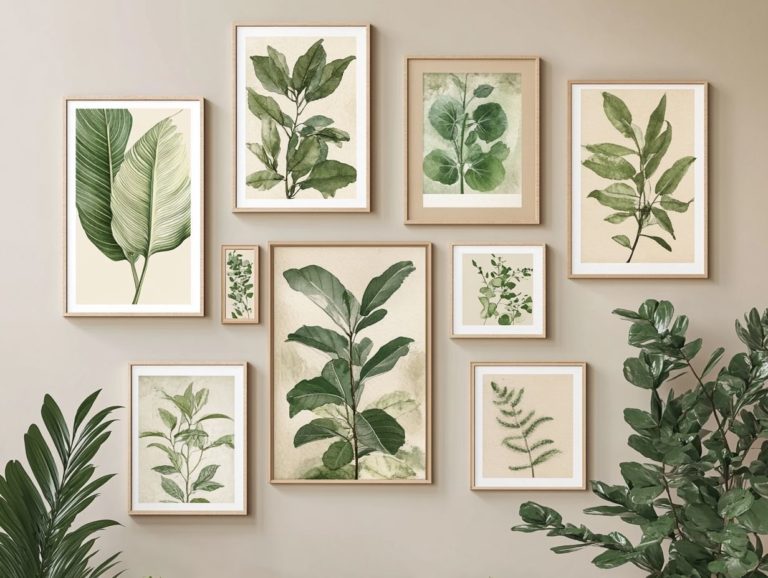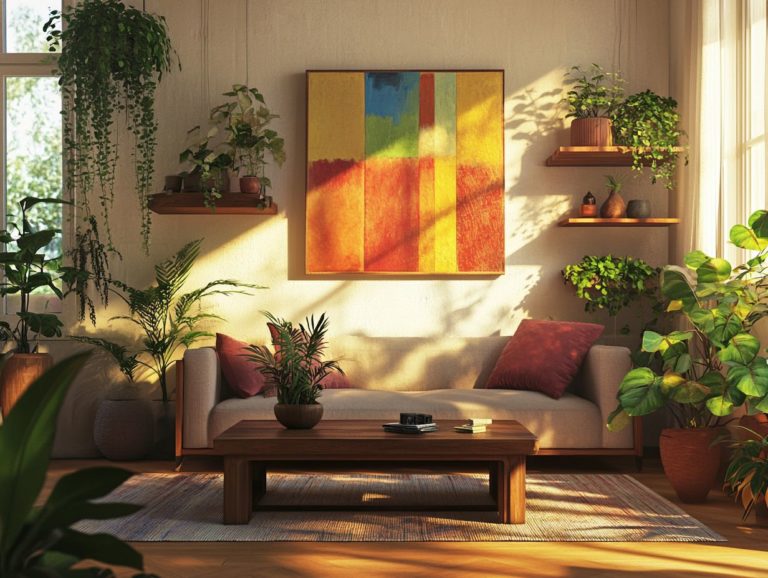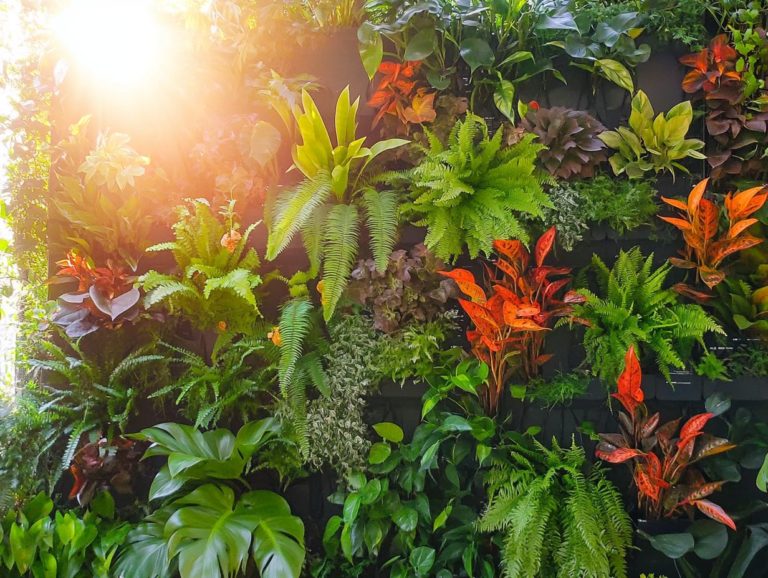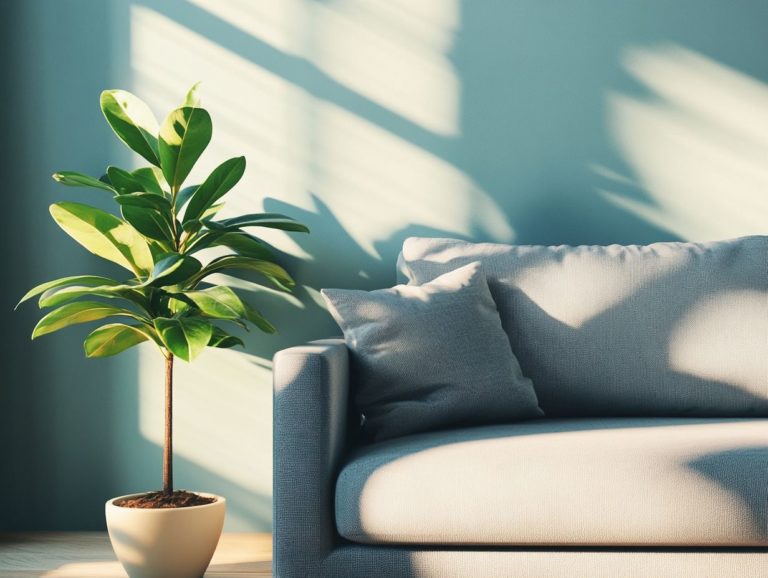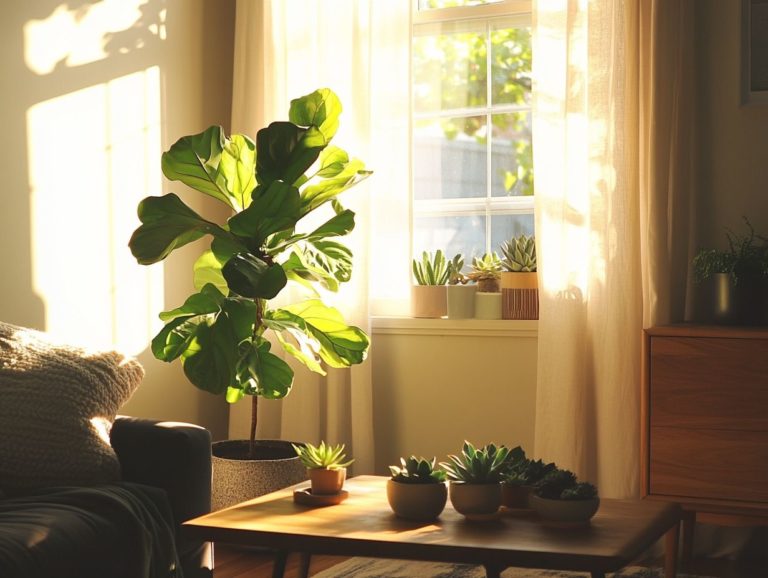Indoor Plants That Thrive in Low Light
Transforming your indoor space can feel like quite the endeavor, particularly when natural light is in short supply. Embracing the concept of low-maintenance plants can make the transition easier.
Understanding low light environments helps you unlock new possibilities for your home or office. This article delves into the various factors that contribute to low light conditions, emphasizes the aesthetic and health benefits of incorporating indoor plants, and showcases the top choices that truly thrive in such settings.
You’ll also discover essential care tips and common pitfalls to avoid, ensuring your leafy companions flourish even in the dimmest corners. Prepare to breathe new life into your space!
Contents
- Key Takeaways:
- Understanding Low Light Environments
- Benefits of Indoor Plants in Low Light
- Top Indoor Plants for Low Light
- Caring for Indoor Plants in Low Light
- Common Mistakes to Avoid
- Frequently Asked Questions
- What are some popular Indoor Plants That Thrive in Low Light?
- Can indoor plants survive in low light environments?
- Do indoor plants that thrive in low light still need some natural light?
- What are the benefits of having indoor plants that thrive in low light conditions?
- How often should I water my indoor plants that thrive in low light conditions?
- Are there any indoor plants that thrive in low light that are safe for pets, such as the beautiful plants like Spider Plant and Boston Fern?
Key Takeaways:
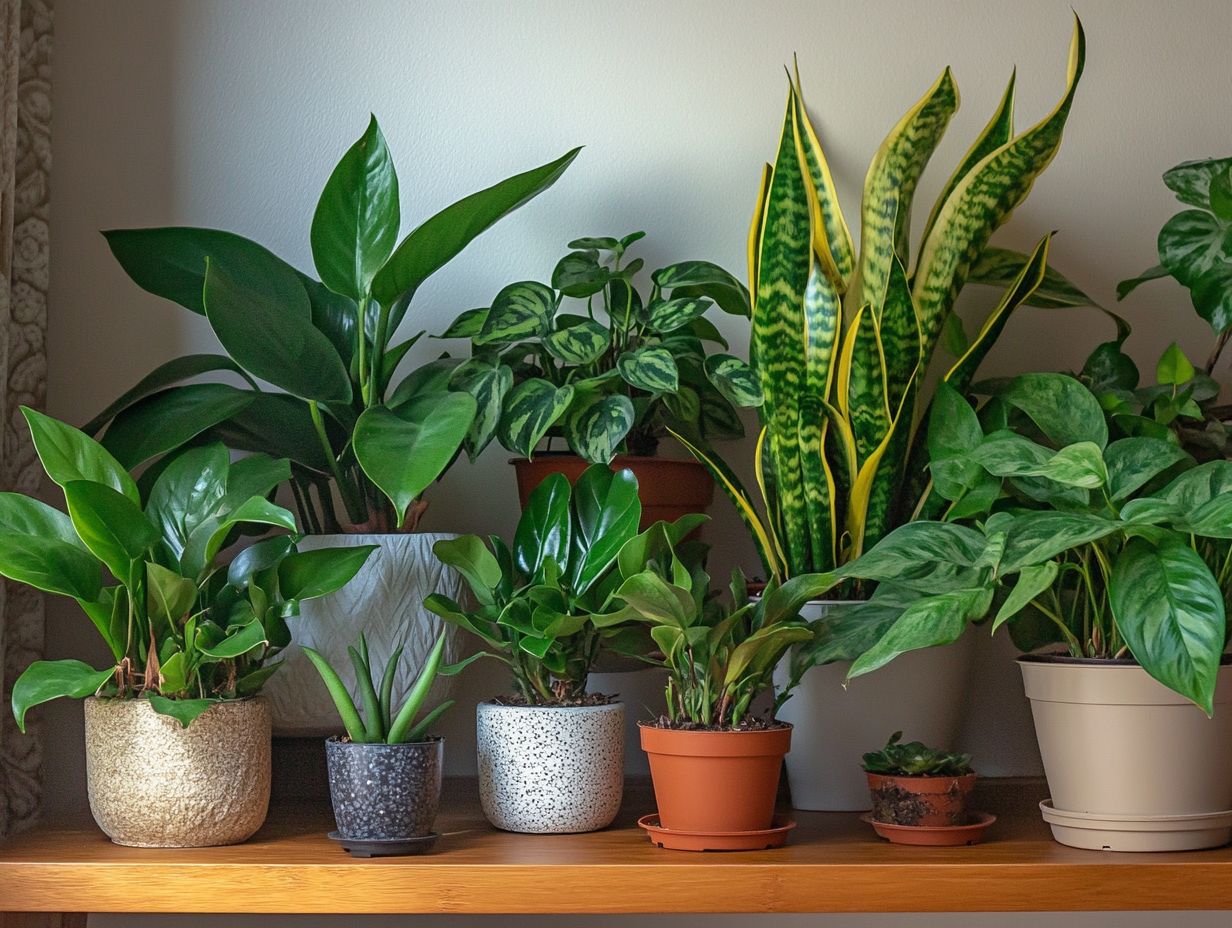
- Indoor plants can thrive in low light. Know how windows and artificial lighting affect their growth to choose the right plants.
- Not only do indoor plants beautify your space, but they also improve air quality and reduce stress. They re perfect for low-light areas!
- When selecting indoor plants, pick low-light adapted species like ferns and peace lilies. Remember to water them regularly and keep them clean!
Understanding Low Light Environments
Understanding low light environments is essential for taking care of indoor plants, as many houseplants can thrive even in these challenging conditions.
The orientation of your home, the size of your windows, and the time of day all play significant roles in determining how much light your plants receive. By recognizing these factors, you enable yourself to make informed decisions about plant selection and care, ensuring your indoor garden flourishes beautifully, even in less-than-ideal lighting. Consider choosing low light indoor plants for optimal results.
Factors that Contribute to Low Light
Several environmental factors contribute to low light conditions, which can significantly impact your indoor plants’ ability to thrive.
Among these factors, room orientation plays a critical role. If you have north-facing windows, you might notice they receive far less sunlight compared to those oriented toward the south or west.
The size of your windows also matters smaller windows can restrict the amount of natural light coming into your space, complicating your plants’ growth even further. Plus, surrounding structures like tall buildings or dense trees can cast shadows, blocking precious sunlight from reaching your green companions.
These elements highlight the importance of carefully assessing light conditions to ensure that the plants you choose can flourish. With the right choices, indoor gardening can be exciting and rewarding!
Benefits of Indoor Plants in Low Light
Indoor plants bring a wealth of benefits, even in low-light conditions. They do more than just elevate your home decor; they also purify the air, contributing to a healthier living environment.
Scientific studies reveal that incorporating beautiful plants into your spaces can enhance air quality, lower stress levels, and improve your overall well-being. These plants also bring a touch of nature to your home, making it not only more inviting but also visually stunning.
Don t miss out on the chance to improve your home s atmosphere with these amazing plants!
Aesthetic and Health Benefits
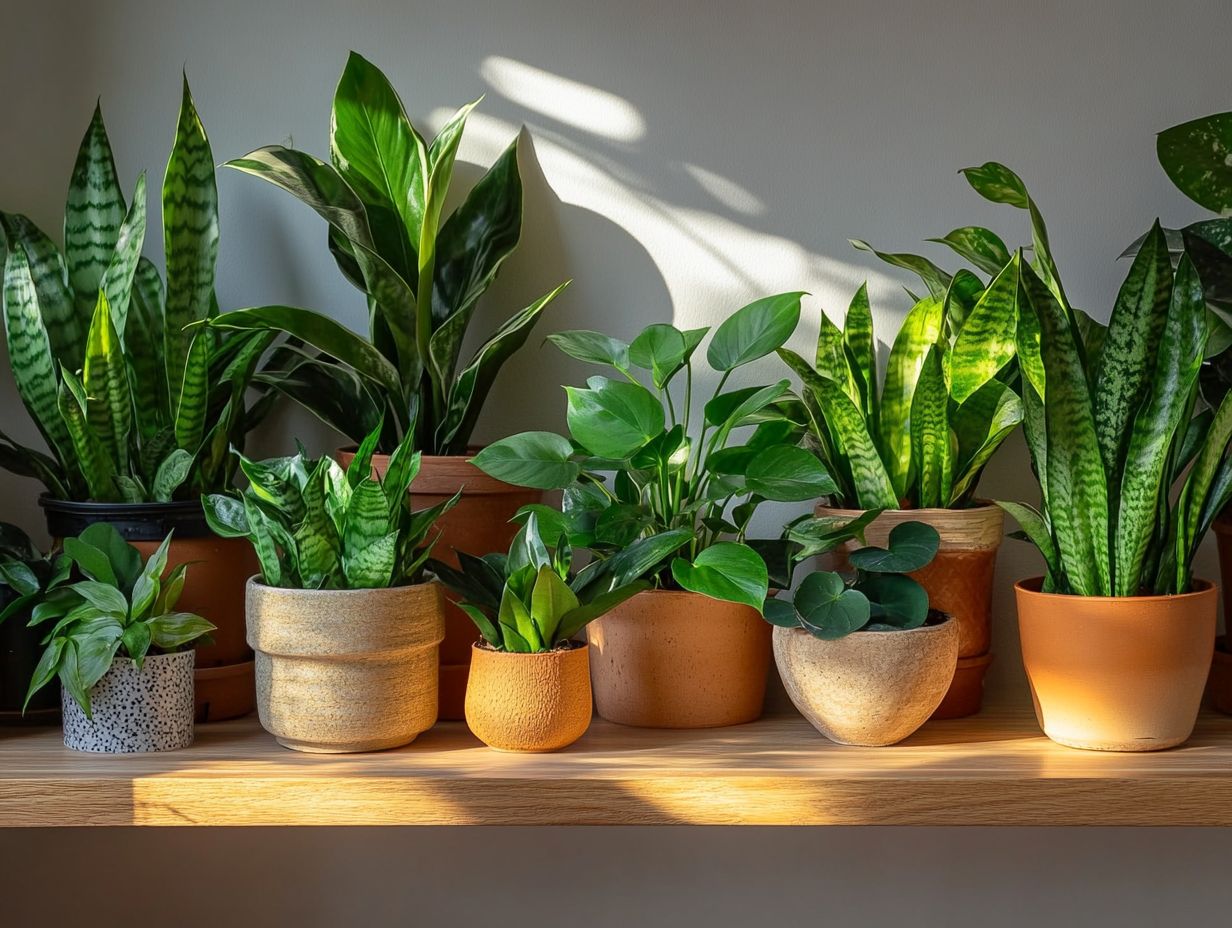
The aesthetic and health benefits of low-light indoor plants are remarkable. They can elevate the ambiance of any space while also enhancing air quality.
By incorporating these plants into your interior design, you enrich your surroundings with vibrant greenery and unlock significant health benefits. Research indicates that surrounding yourself with nature can effectively lower stress levels, offering a calming effect that promotes relaxation.
Including air-purifying plants can enhance your concentration, making them ideal companions for your home office or study area.
This harmonious blend of aesthetic appeal and health advantages positions low-light plants as the perfect choice for anyone eager to cultivate a serene and inspiring environment.
Top Indoor Plants for Low Light
Selecting the best indoor plants for low-light conditions can elevate your indoor gardening experience. A variety of plants brings distinct characteristics tailored for challenging environments.
Experts often recommend plants like the Snake Plant, ZZ Plant, and Peace Lily. These plants are celebrated for their resilience in low light and their air-purifying abilities.
These incredible plants will not only brighten your space but also demand minimal upkeep, making them perfect companions for any home.
Types and Characteristics of Low Light Plants
When exploring the world of low-light plants, consider delightful houseplants like Dracaena, Boston Fern, and Pothos. Each of these plants flourishes beautifully in indoor spaces with limited natural light.
The Dracaena stands tall with its upright, arching leaves. It s a perfect choice for cozy corners or entryways needing a touch of greenery.
Boston Ferns thrive in more humid conditions, presenting a lush, bushy appearance that softens any room’s atmosphere.
Pothos, with its remarkable versatility, can either trail gracefully or climb, effortlessly adapting to its environment.
For successful propagation, these plants typically demand minimal maintenance. They thrive best in indirect light and well-draining soil, highlighting the need for attentive care to ensure their longevity.
Caring for Indoor Plants in Low Light
Caring for indoor plants in low light requires a simple understanding of their specific watering needs and maintenance requirements. This ensures that each houseplant not only survives but thrives in challenging conditions.
Adopting proper watering practices and consistently monitoring plant health are crucial steps in keeping your low-maintenance plants vibrant and flourishing.
Each variety, whether it’s the resilient Cast Iron Plant or the sophisticated Anthurium, comes with its own unique care tips that can enhance their growth and longevity in low light environments. For those looking for options, consider exploring indoor plants that thrive with minimal water.
Tips for Maintaining Healthy Plants
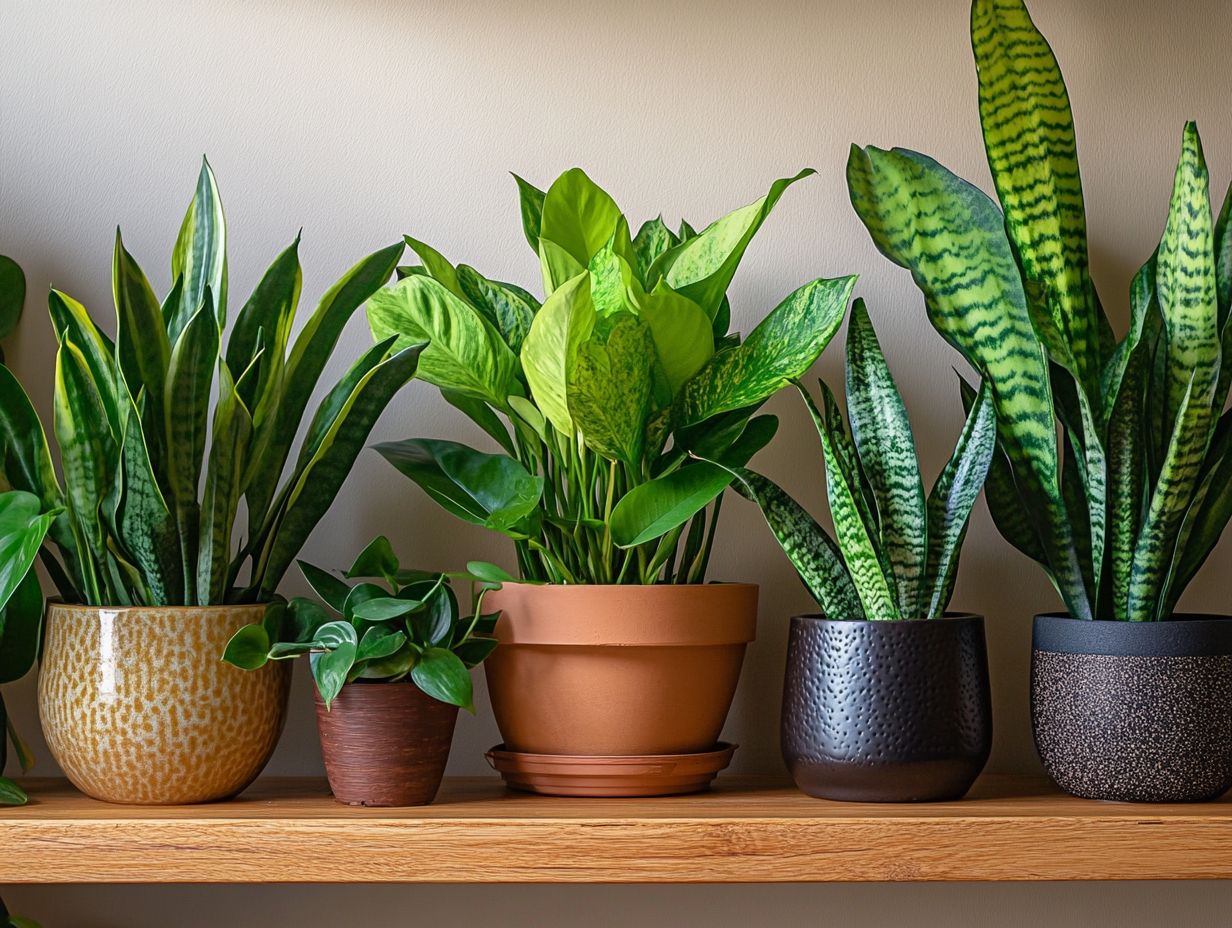
To keep your indoor plants thriving in low light, it’s essential to adopt specific strategies for their care and watering needs.
Recognizing the unique requirements of each plant variety is key to promoting healthy growth. In terms of watering, aim for soil that remains gently moist but never waterlogged. Overwatering can cause the roots to rot, which harms the plant.
Choosing well-draining pots can help maintain the right moisture levels. Pest management is equally important; inspect leaves frequently to catch any infestations early and consider using natural remedies like neem oil as an effective solution.
Don t overlook the environmental factors, such as humidity and temperature. Adjust your indoor gardening setup to create the perfect ambiance for your plants, allowing them to truly flourish.
Common Mistakes to Avoid
Don’t let common mistakes sabotage your indoor gardening! It’s vital to keep your plants healthy and thriving, especially in low light.
Avoiding common mistakes ensures the health and longevity of your plants. This is particularly important when nurturing them in low light conditions, where potential pitfalls can greatly affect their growth.
Potential Pitfalls and How to Avoid Them in Indoor Gardening
Spotting common indoor gardening pitfalls can keep your plants thriving! Recognizing potential issues when caring for your plants in low light is crucial for keeping them happy and encouraging healthy growth, especially for popular houseplants that require specific care.
You might encounter common issues like improper watering techniques, which can lead to overwatering and root rot, or underwatering, which stunts growth. If you neglect to clean the leaves, your plants can struggle to make food from sunlight, ultimately diminishing their vitality.
Be careful when choosing plants that are toxic to pets or children, as they can pose risks in your home.
To sidestep these challenges, establish a consistent watering schedule, gently wipe the leaves regularly, and carefully select non-toxic plant varieties. Act now to ensure your plants flourish by creating a thriving environment that promotes overall well-being for both your plants and your household.
Frequently Asked Questions
Got questions about indoor plants? Here are the most frequently asked ones!
What are some popular Indoor Plants That Thrive in Low Light?

Some popular indoor plants that thrive in low light include snake plants, pothos, peace lilies, ZZ plants, and the resilient Monstera, making them excellent choices for any indoor gardening enthusiast.
Can indoor plants survive in low light environments?
Yes, many indoor plants are adapted to low light conditions and can thrive in them. Knowing about these plant types is essential for a successful indoor garden, as they have adapted to survive in the understory of forests where light is limited.
Do indoor plants that thrive in low light still need some natural light?
Yes, even though these plants can survive in low light, they still need some natural light to thrive. It is recommended to place them near a window that receives indirect or filtered sunlight.
What are the benefits of having indoor plants that thrive in low light conditions?
Indoor plants not only add a touch of greenery to your space, but they also provide many benefits. Indoor plants boost air quality, reduce stress, and enhance mood and productivity.
How often should I water my indoor plants that thrive in low light conditions?
The watering frequency for these plants will depend on factors such as the type of plant, pot size, and environment. It is best to check the soil moisture before watering and adjust accordingly.
Are there any indoor plants that thrive in low light that are safe for pets, such as the beautiful plants like Spider Plant and Boston Fern?
Yes, there are many indoor plants that are safe for pets and can thrive in low light. Some pet-friendly options include spider plants, African violets, and bamboo palm. However, it is always best to research a plant’s toxicity before bringing it into a pet-friendly home.

